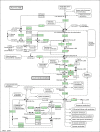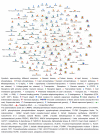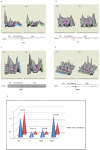First evidence of overlaps between HIV-Associated Dementia (HAD) and non-viral neurodegenerative diseases: proteomic analysis of the frontal cortex from HIV+ patients with and without dementia
- PMID: 20573273
- PMCID: PMC2904315
- DOI: 10.1186/1750-1326-5-27
First evidence of overlaps between HIV-Associated Dementia (HAD) and non-viral neurodegenerative diseases: proteomic analysis of the frontal cortex from HIV+ patients with and without dementia
Abstract
Background: The pathogenesis of HIV-associated dementia (HAD) is poorly understood. To date, detailed proteomic fingerprinting directly from autopsied brain tissues of HAD and HIV non-dementia patients has not been performed.
Result: Here, we have analyzed total proteins from the frontal cortex of 9 HAD and 5 HIV non-dementia patients. Using 2-Dimensional differential in-gel electrophoresis (2-DIGE) to analyze the brain tissue proteome, 76 differentially expressed proteins (p < 0.05; fold change>1.25) were identified between HAD and HIV non-dementia patients, of which 36 protein spots (based on 3D appearance of spots on the images) were chosen for the mass spectrometry analysis. The large majority of identified proteins were represented in the energy metabolic (mitochondria) and signal transduction pathways. Furthermore, over 90% of the protein candidates are common to both HAD and other non-viral neurodegenerative disease, such as Alzheimer's disease. The data was further validated using specific antibodies to 4 proteins (CA2, GS, CKMT and CRMP2) by western blot (WB) in the same samples used for 2D-DIGE, with additional confirmation by immunohistochemitsry (IHC) using frontal lobe tissue from different HAD and HIV+ non-dementia patients. The validation for all 4 antibodies by WB and IHC was in concordance with the DIGE results, lending further credence to the current findings.
Conclusion: These results suggest not only convergent pathogenetic pathways for the two diseases but also the possibility of increased Alzheimer's disease (AD) susceptibility in HAD patients whose life expectancy has been significantly increased by highly active antiretroviral therapy.
Figures








Similar articles
-
Proteomics Profiling with SWATH-MS Quantitative Analysis of Changes in the Human Brain with HIV Infection Reveals a Differential Impact on the Frontal and Temporal Lobes.Brain Sci. 2021 Oct 28;11(11):1438. doi: 10.3390/brainsci11111438. Brain Sci. 2021. PMID: 34827437 Free PMC article.
-
Plasma protein profiling for potential biomarkers in the early diagnosis of Alzheimer's disease.Neurol Res. 2017 Mar;39(3):231-238. doi: 10.1080/01616412.2017.1281195. Epub 2017 Jan 20. Neurol Res. 2017. PMID: 28107809
-
Proteomic analysis of human frontal and temporal cortex using iTRAQ-based 2D LC-MS/MS.Chin Neurosurg J. 2021 May 5;7(1):27. doi: 10.1186/s41016-021-00241-5. Chin Neurosurg J. 2021. PMID: 33952343 Free PMC article.
-
Plasma neuronal exosomes serve as biomarkers of cognitive impairment in HIV infection and Alzheimer's disease.J Neurovirol. 2019 Oct;25(5):702-709. doi: 10.1007/s13365-018-0695-4. Epub 2019 Jan 4. J Neurovirol. 2019. PMID: 30610738 Free PMC article. Review.
-
Does HIV infection contribute to increased beta-amyloid synthesis and plaque formation leading to neurodegeneration and Alzheimer's disease?J Neurovirol. 2019 Oct;25(5):634-647. doi: 10.1007/s13365-019-00732-3. Epub 2019 Mar 13. J Neurovirol. 2019. PMID: 30868421 Review.
Cited by
-
Hierarchical CRMP2 posttranslational modifications control NaV1.7 function.Proc Natl Acad Sci U S A. 2016 Dec 27;113(52):E8443-E8452. doi: 10.1073/pnas.1610531113. Epub 2016 Dec 8. Proc Natl Acad Sci U S A. 2016. PMID: 27940916 Free PMC article.
-
Proteomics, biomarkers, and HIV-1: A current perspective.Proteomics Clin Appl. 2016 Feb;10(2):110-25. doi: 10.1002/prca.201500002. Epub 2015 Jul 8. Proteomics Clin Appl. 2016. PMID: 26033875 Free PMC article. Review.
-
1H-NMR metabolomics investigation of CSF from children with HIV reveals altered neuroenergetics due to persistent immune activation.Front Neurosci. 2024 Apr 30;18:1270041. doi: 10.3389/fnins.2024.1270041. eCollection 2024. Front Neurosci. 2024. PMID: 38745940 Free PMC article.
-
Cross-talk between lipid homeostasis and endoplasmic reticulum stress in neurodegeneration: Insights for HIV-1 associated neurocognitive disorders (HAND).Neurochem Int. 2020 Dec;141:104880. doi: 10.1016/j.neuint.2020.104880. Epub 2020 Oct 14. Neurochem Int. 2020. PMID: 33065212 Free PMC article. Review.
-
Homology-guided mutational analysis reveals the functional requirements for antinociceptive specificity of collapsin response mediator protein 2-derived peptides.Br J Pharmacol. 2018 Jun;175(12):2244-2260. doi: 10.1111/bph.13737. Epub 2017 Mar 17. Br J Pharmacol. 2018. PMID: 28161890 Free PMC article.
References
-
- Cysique LA, Maruff P, Brew BJ. Prevalence and pattern of neuropsychological impairment in human immunodeficiency virus-infected/acquired immunodeficiency syndrome (HIV/AIDS) patients across pre- and post-highly active antiretroviral therapy eras: a combined study of two cohorts. Journal of neurovirology. 2004;10:350–357. doi: 10.1080/13550280490521078. - DOI - PubMed
-
- Dore GJ, McDonald A, Li Y, Kaldor JM, Brew BJ. Marked improvement in survival following AIDS dementia complex in the era of highly active antiretroviral therapy. AIDS (London, England) 2003;17:1539–1545. - PubMed
-
- Sui Y, Potula R, Pinson D, Adany I, Li Z, Day J, Buch E, Segebrecht J, Villinger F, Liu Z, Huang M, Narayan O, Buch S. Microarray analysis of cytokine and chemokine genes in the brains of macaques with SHIV-encephalitis. Journal of medical primatology. 2003;32:229–239. doi: 10.1034/j.1600-0684.2003.00030.x. - DOI - PubMed
LinkOut - more resources
Full Text Sources
Other Literature Sources
Miscellaneous

